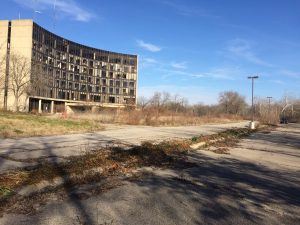Chelsea Schneider, Municipal Innovations Specialist, Aim
For nearly a decade, an abandoned building has marred a main corridor through Richmond. The property, which once served as a hospital campus, deteriorated and is a major safety hazard.
Now, the eyesore is coming down, after Richmond Mayor Dave Snow’s administration navigated a series of hurdles to demolish the blighted building. The action is a huge boost not only to the aesthetics of a well-traveled route but the community’s collective optimism about Richmond’s future.
 Since the early 1900s, Reid Health had operated at the site, before completing its move to a new location in 2008. Though hospital leaders did their due diligence in selling the building, the property’s ownership changed hands a couple of times following the transaction, Snow said.
Since the early 1900s, Reid Health had operated at the site, before completing its move to a new location in 2008. Though hospital leaders did their due diligence in selling the building, the property’s ownership changed hands a couple of times following the transaction, Snow said.
That uncertainty led to the property’s current state.
“Once the building was left to sit and rot that way, it implied that no one cared anymore,” Snow said. “It means a lot to the community to see something be done.”
In its prime, the site had served as an anchor for the community, where residents welcomed and said goodbye to family members. Most of the building’s windows are now shattered, and the back portion sits in a flood plain and has 11 feet of standing water. Cleaning up the site will clear the way for a new use, but it also will show respect to the people whose lives were touched at Reid’s original location.
The demolition also will mitigate a public safety hazard. Richmond police routinely get calls about people seeing flashlights in the building.
“It’s very unsafe for police and fire to enter,” Snow said. “The building is rotting away, so for me, that was keeping me awake at night. We were on a time clock before someone was very seriously hurt or worse in that building, and we’re putting our first responders in danger trying to help them.”
 The city had originally planned financing the site’s remediation and demolition through Indiana Finance Authority loans – and the state’s early support for the project gave city leaders the confidence to move forward. Ultimately, cost estimates for remediating and demolishing the site came in more affordable than anticipated, the county committed $1.42 million to the project and Reid Health added a $1 million contribution, allowing the city to fund the balance of the project locally through tax-increment financing. Using TIF means the city won’t have to take out a lengthy loan for the project, Richmond’s controller Beth Fields said.
The city had originally planned financing the site’s remediation and demolition through Indiana Finance Authority loans – and the state’s early support for the project gave city leaders the confidence to move forward. Ultimately, cost estimates for remediating and demolishing the site came in more affordable than anticipated, the county committed $1.42 million to the project and Reid Health added a $1 million contribution, allowing the city to fund the balance of the project locally through tax-increment financing. Using TIF means the city won’t have to take out a lengthy loan for the project, Richmond’s controller Beth Fields said.
The city also is in the final stages of acquiring the property. And while city leaders haven’t determined a new use, its ownership will provide a wider array of options.
“This was only possible through a partnership among the mayor’s office, city council, county council, county commissioners,” Snow said. “It required that partnership to get done. There’s so much to be said about putting all the agendas and political party lines aside and everyone sitting at a table for a project that betters the community.”
Working toward the building’s demolition took tiny steps and consensus building, Snow said. Now, the community can look toward its future and not its past.
“What it’s doing for the people of the community, it’s allowed them to stop looking back. Everybody had been really stuck looking back over that mistake and what happened and what got us there,” Snow said. “It’s sort of untethering from that so we can work ahead. We can put it to bed and look forward and that’s the biggest win out of this.”
